
13 minute read
GRIST FOR THE MILL
WHEN TURNER BOOTH PONDERED BUYING THE RUNDOWN GLEN ARBOR MILL, LITTLE DID HE KNOW HOW MUCH ITS PAST WOULD SHAPE ITS FUTURE—AND HIS.
by Elizabeth Edwards
Five years ago, Turner Booth, a young real estate attorney who’d been working in New York City, took a career breather and relocated to Glen Arbor where he’d summered since he was a child. Initially, he stayed in his parents’ home at The Homestead resort just north of town. His route to and from the small downtown took him past the old mill. With its broken windowpanes and peeling white paint, the massive, three-story building set on a small peninsula looped by the sandy-bottomed Crystal River was hauntingly handsome.
Like most folks who live or vacation in Glen Arbor, Booth wondered what was going to become of the old structure—neither the mill nor the sweet Queen Anne–style miller’s house that sits next to it looked like they could withstand many more Northern Michigan winters without some serious triage. At the time, both buildings were owned by a local resort, whose owner had purchased them in the 1980s to use as headquarters for a golf course he’d wanted to build along the river. The golf course never materialized, so the mill was used for storage.
Not long after he’d moved to Glen Arbor, Booth ran into the mill’s owner and asked him what his plans were for it. “He said, ‘Why, do you want to buy it?’ And that made me think maybe I do,” Booth recalls. Booth toured the building in the late summer of 2018—a season when the Crystal River is at its zenith with huge salmon finning in from the depths of Lake Michigan to spawn under banks tangled with water lilies, wild blueberries, deep-green ferns and red cardinal flowers. By contrast, the mill was a gloomy mess—packed as it was nearly top to bottom with golf carts, snowmobiles, old furniture and “boxes stacked on top of boxes,” Booth says. Some shoving, moving and nosing around, however, revealed much more: the mill’s ancient equipment was all intact—73 years after the last Glen Arbor miller, August Brammer, locked the door and shuttered his business in 1945.
In the cavernous great room with its pine paneling, oak trusses, posts and beams, Booth uncovered four milling machines: The two oldest—at least one dating back to the 1860s—were grist mills, their old stones encased in half barrels, their hoppers perched funnel-side down on a lovely little base with turned legs. Across the room were twin roller mills, squat, funky machines whose steel rollers were the technological jump that produced the finer, whiter flour that Americans became used to in the early part of the last century. Even the math penciled across a post in the great room by a long-ago miller was still legible.
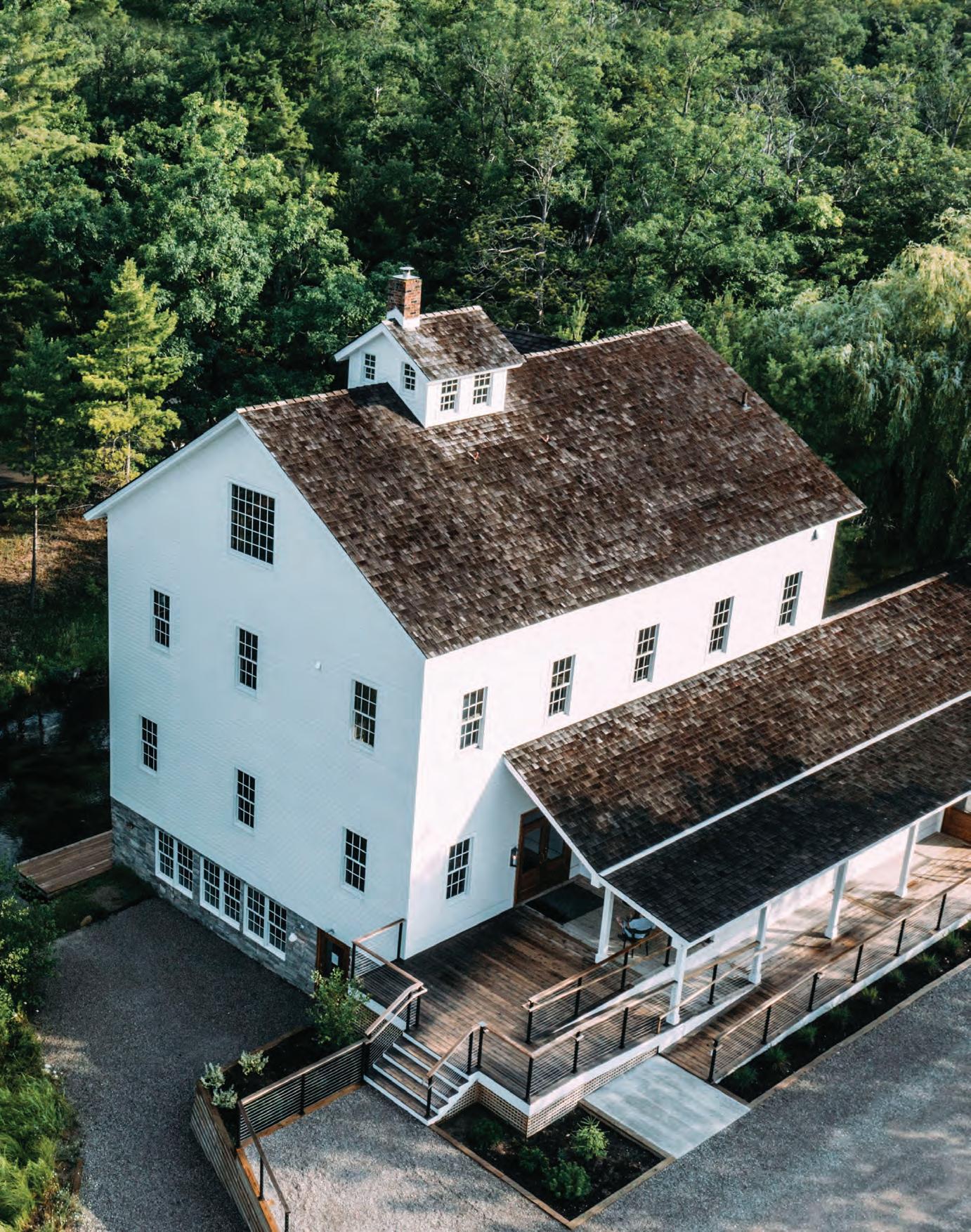

There was more: the wooden chute where the grist was conveyed up to the second floor was still in place, and the second floor held two huge bolters, machines that were used to sift the grist—the grain that will become flour. The newest of the two, from 1906, still had its directions tacked to the post next to it. “I saw everything that was in there—how intact the building was,” Booth says. “I felt like we—the community—we can’t let this thing just fall over. We can’t let the roofs fall in. It’s too beautiful. There are too many cool things inside this building to be shared.”
Several months later, Booth purchased the building and adjacent miller’s house and from the get-go knew he wanted to do his best to preserve its rich history through some sort of adaptive reuse that the public could enjoy. The question was: How, exactly?
Conventional corporate-style branding (install a modern eatery, throw history a bone by naming a burger The Old Mill) never appealed to him. Booth mulled ideas with family and friends—a coffee shop/wellness studio/small museum of mill artifacts were all maybes. But the vision didn’t gel until he met Kelsey Duda and her company Fernhaus Hospitality Group. Duda has won national acclaim for an Airbnb she designed, built and then furnished with carefully curated vintage elements in Elk Rapids. “Whenever I’m designing a brand or concept, I start with the history of the place and land as a source of inspiration,” she told Domino magazine in a 2021 interview. After she saw the mill for the first time, Duda says, “I just fell in love with it. It’s one of those projects I knew I’d have to be a part of no matter what.”
Booth and Duda tossed ideas around, discussed each one down to its very kernel, then went back and kneaded them some more. “For the last two years we’ve either been working together or on the phone together—seven and eight hours a day—talking about what this could be,” Booth says.
Along the way, the pair gleaned the mill’s history from the few old-timers who still remembered it in operation, and chatted with local contractor Don Lewis who, with his friend Fred Ball, had turned the mill into a recording studio in the 1970s. Local historians helped flesh out the mill’s past, too, among them the executive director of the Leelanau Historical Society, Kim Kelderhouse, whose great-great-grandfather Thomas Kelderhouse built the mill in 1879.
Through research, nuggets of the past emerged to paint a picture of life at the mill and its importance to the community. In the early winter of 1880, for instance, the dam on the mill pond broke. “It is quite a loss to the whole community around for many families were out of flour …” the local newspaper reported. Another recollection recounted how the wife of one of the millers poured coffee and served doughnuts to farmers waiting in line for their mill to be ground. And then there was 9-year-old Maude Kelderhouse’s letter to the Grand Traverse Herald in 1885, where she wrote about living at the Glen Arbor grist mill where her father was miller: “I help mamma sew carpet rags and do a great many other things for her. I have a pet chicken and his name is Ned,” she wrote.
One of the two grist mills that have sat in the corner of the big room for almost 150 years. The 19th-century poem stenciled on the wall by Heather Spooner of Ampersand Lettering Lab was a surprise for Booth from his staff.

Stand in front of the little white mill keeper’s house nowadays and it isn’t hard to imagine Maude skipping off the stoop, Ned the chicken clucking and scurrying to catch up with her, to greet the farmers pulling into the mill with their wagons loaded with grain. Most of the mills’ customers were subsistence farmers who worked the poor sandy soil of Port Oneida—an isolated hamlet (now a rural historic district owned by S leeping Bear Dunes National Lakeshore) several miles north of the mill. Milling day was a chance to socialize for whole families, and the banks of the quiet river would come to life with children playing and adults chattering about the latest news.
When the miller opened the dam, river water rushed to turn the horizontal waterwheels located under the building, which powered the shaft that turned the stones (or rollers) that ground the wheat into flour for toasty loaves of bread and warm pies that filled bellies in drafty farmhouses.
As their vision for the mill took shape, Booth and Duda sifted all they’d learned down to the fundamental ingredients that could bring their entire business plan into a cohesive, one-of-a-kind hospitality experience. One ingredient stood out above all the rest: flour. Simple, wholesome, old-fashioned flour. “If we are serving baked goods at a mill, we have to have good flour,” Booth says.
At 8 a.m. on a warm morning this summer, The Mill Glen Arbor, as it is now known, was powering into its daily routine—a routine that quickly established itself after a muted soft opening on a gray, drizzly day in March. They might not have been fully conscious of it, but the customers walking lazily up to the big white building and through its oak doors were stepping into a timeless setting—one that hovers between the homely simplicity of 19th-century rural America and the elements that contemporary sensibilities say are good for our bodies and souls: whole grains, local produce, fine coffee and libations, community.
There’s often a small awestruck stutter from newcomers entering the great room where the hand-hewn beams and posts still wear their dark varnish and the walls are still clad in pine slats. New windows mimic the originals. The miller’s scrawled math remains legible on that big central post. Both pairs of mills, the stone and the roller, are still where they have always been, on a platform at the side of the room. Duda has outfitted the room in tasteful, comfortable furniture that welcomes gathering—or finding a place to work alone on your laptop. “It’s supposed to feel like Midwest hospitality—like you’re walking into a family room with friends,” Booth says.
The coffee shop, located in a newer wing added during the music studio era, is to the right, past a wall that exhibits the beginning of Booth’s collection of historical mill memorabilia. The baked goods case is stuffed with cardamom-molasses cookies, hearty whole-wheat loaves, hand-pies fat with local cherries, and voluptuous sourdough boules made from sourdough starter that has traveled with baker Miriam Geenen for years. When Geenen (who last baked at renowned Zingerman’s Deli in Ann Arbor) heard the philosophy behind the mill and set eyes on it, she knew she was in.


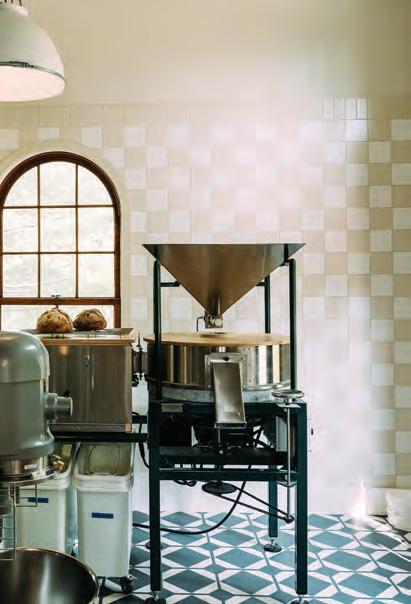

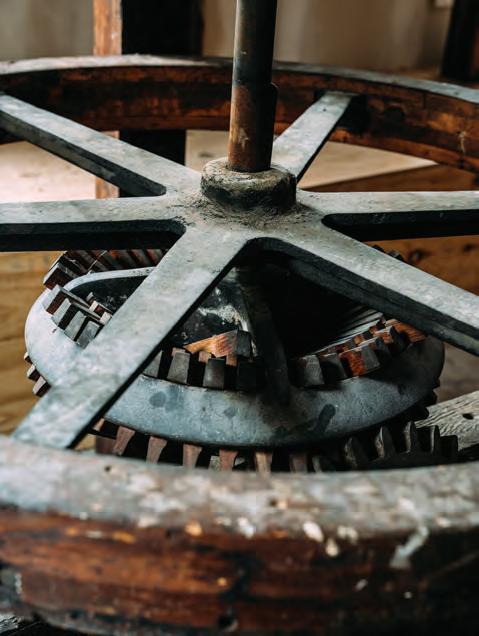
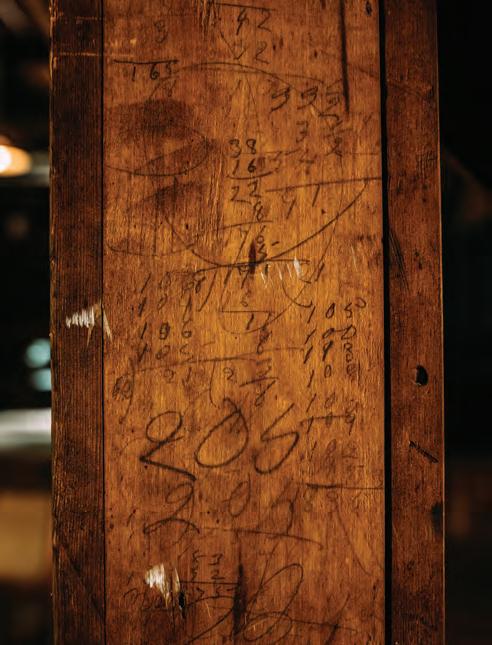
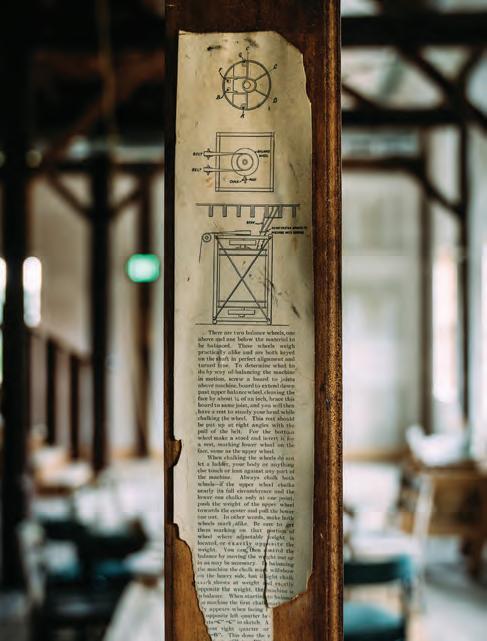
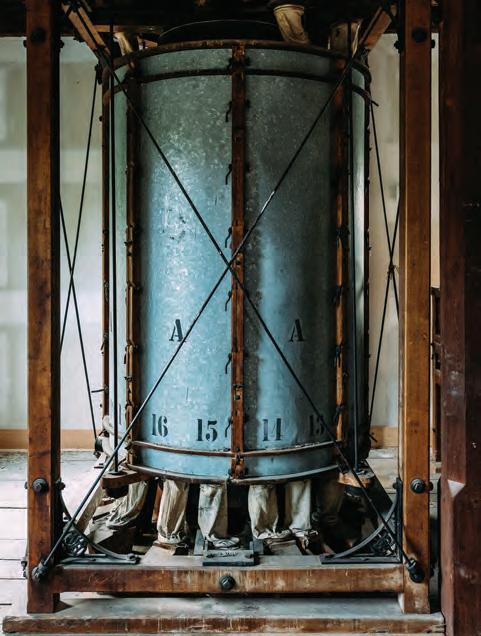
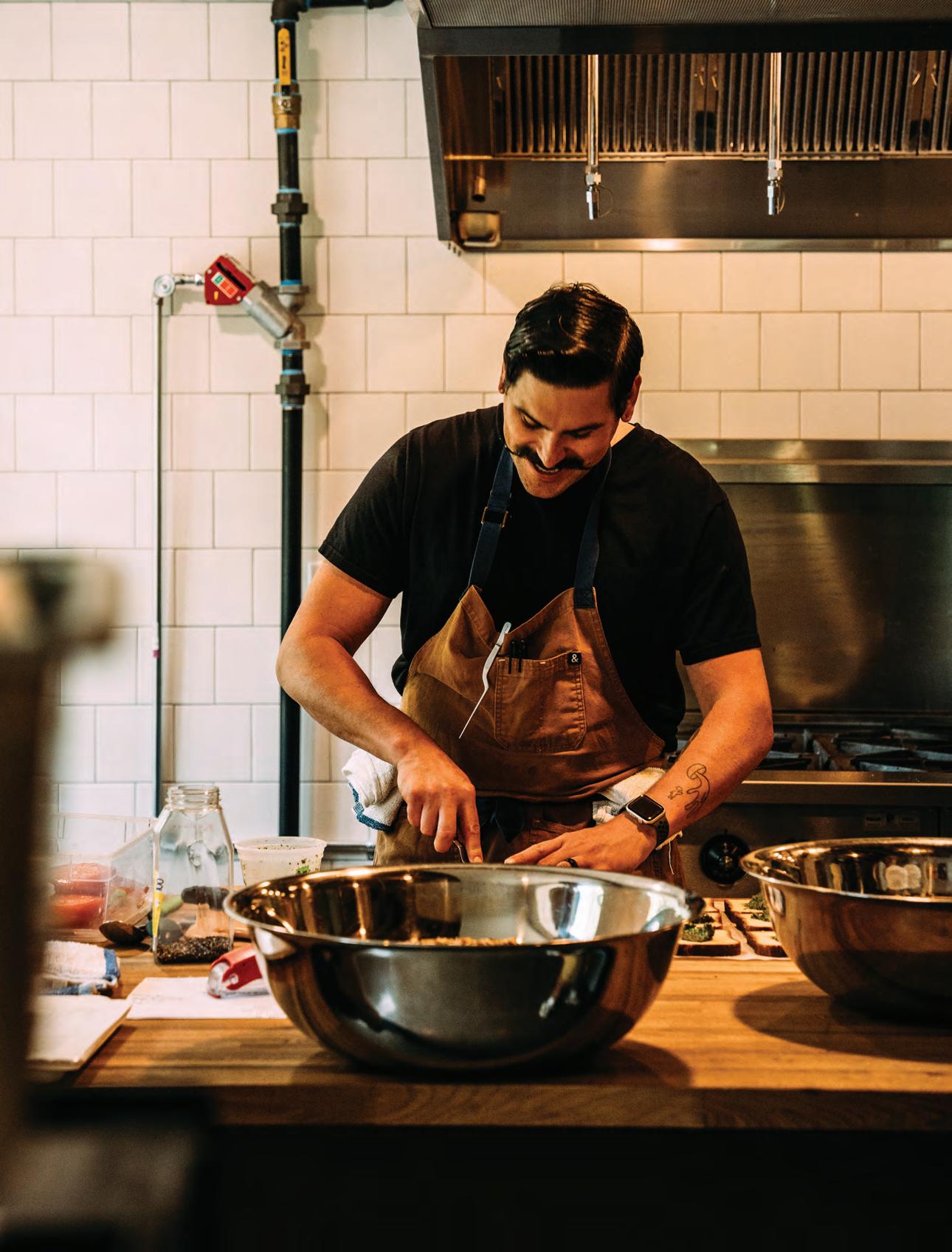
Below: Friends gather in a corner of the big room, in front of the two roller mills that have been there since 1906; three suites in the farmhouse where young Maude (and Ned the chicken) once lived can be rented at themillglenarbor.com. Opposite: Once again, kids can visit the mill and dangle their feet in the shallow Crystal River.

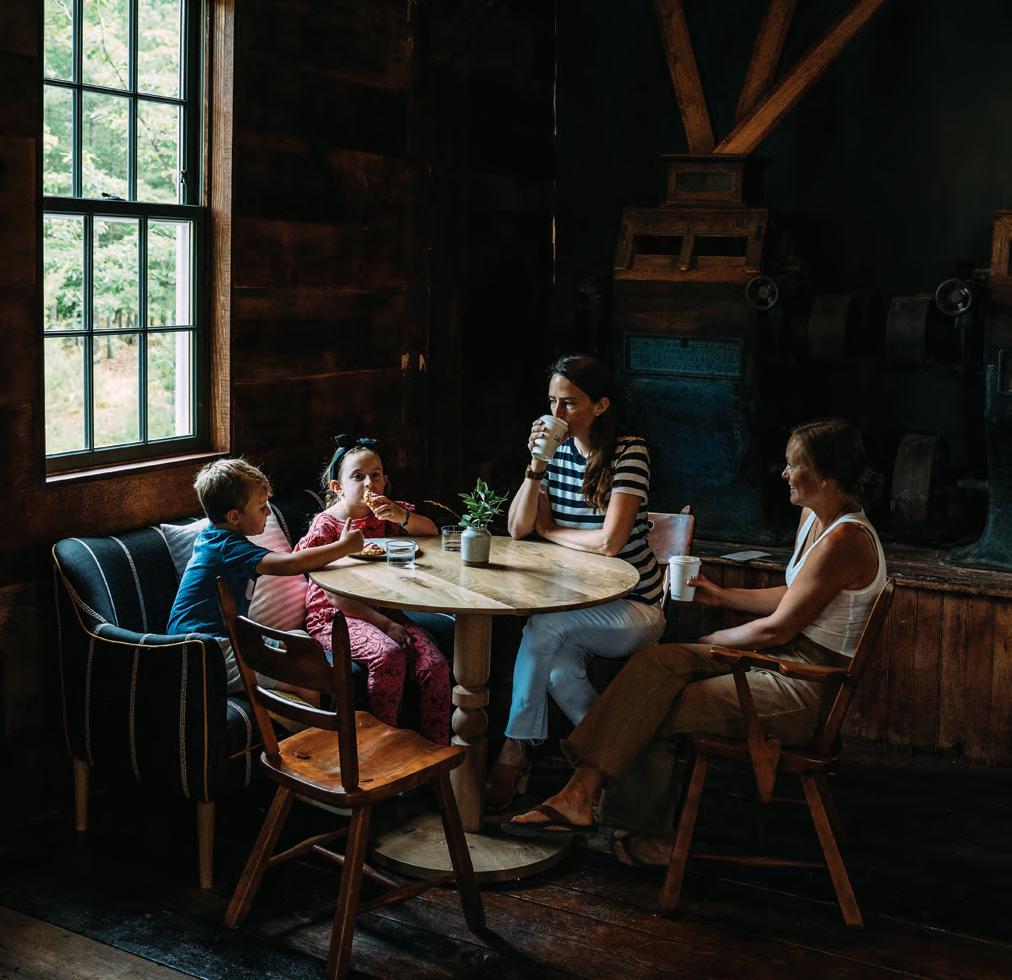
“It’s really hard to walk away from this,” she says.
In the bright little shop, guests order coffee and baked goods, plus homemade sandwiches and a tasteful selection of wine and beer and take it all into the great room or out onto the deck overlooking the Crystal River. As they do, they might notice a shiny stainless-steel machine behind glass. It’s a stone mill made in Elmore, Vermont. As innocuous as it may look, the new mill is “the heart of this place,” says Booth. Early mornings, Geenen flips the on switch and mills heritage grains sourced as locally as possible for the 50-some loaves of bread she will bake that day.
There is still more to come at The Mill Glen Arbor. A casual 30-seat bistro downstairs with an open kitchen and views of minnows darting in the river is scheduled to open at this summer’s end. And next summer, Booth says, his face breaking into an old-fashioned grin, the mill will grind its own grain—grown by a soon-tobe-hired farmer on a hundred acres located just a few miles north of Port Oneida, and then transported to Glen Arbor to be milled in that new stainless stone mill.
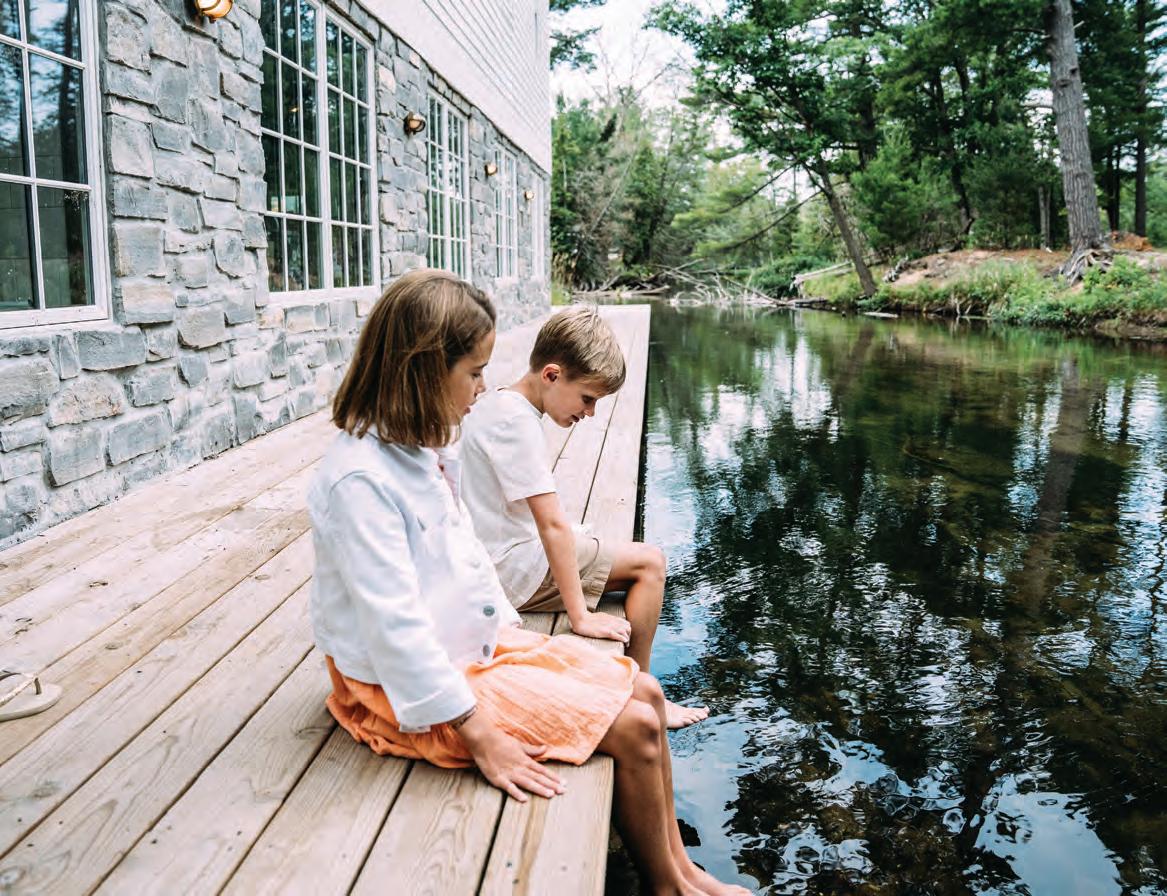
Although Booth has barely paused to breathe since he closed on the mammoth old structure—a massive renovation project, a marriage, a new baby, and now a new business—he is more certain than ever that saving the old building was worth it. Once again, the mill will gather community, knitting together farm and baker, hearth and hospitality, a testament to sturdy old beams and good bones and the love of a place that runs deeper than the river that turns the stones.
Elizabeth (Lissa) Edwards is senior editor of Traverse Northern Michigan. She has been writing about the region’s history, outdoors and lifestyle for over 30 years.
Andy Wakeman, an editorial and commercial photographer, was born and raised in Northern Michigan. He enjoys exploring beaches, meeting interesting folks and braving Northern Michigan snowstorms, camera in hand. andywakemanphoto.com is for Autumn and Antiques
Looking for an out-and-about fall afternoon packed with delights? These four road-trip destinations are filled with untold treasures.
By Allison Jarrell, Cara McDonald, Carly Simpson & Lissa Edwards

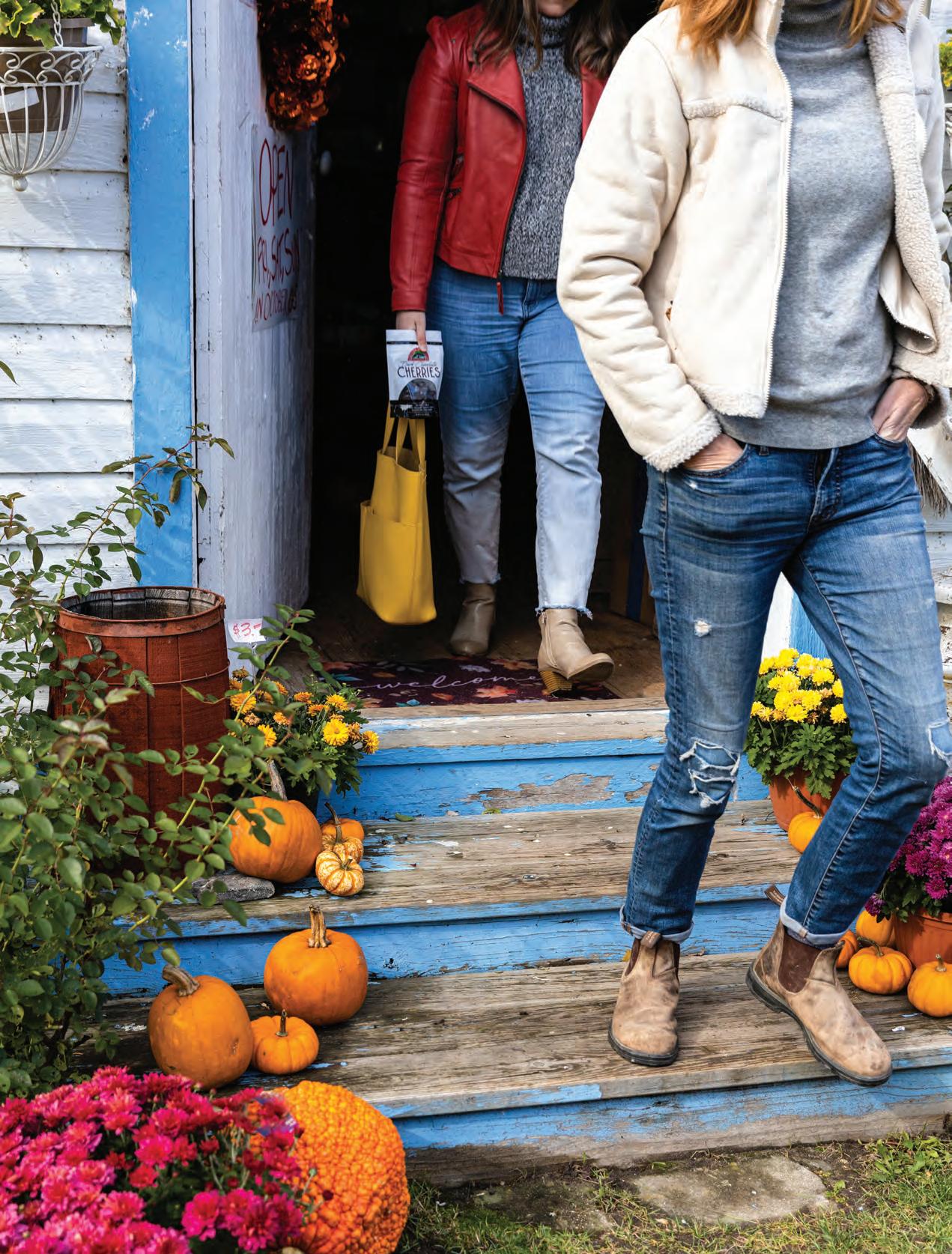
Destination
Elk Rapids Antiques

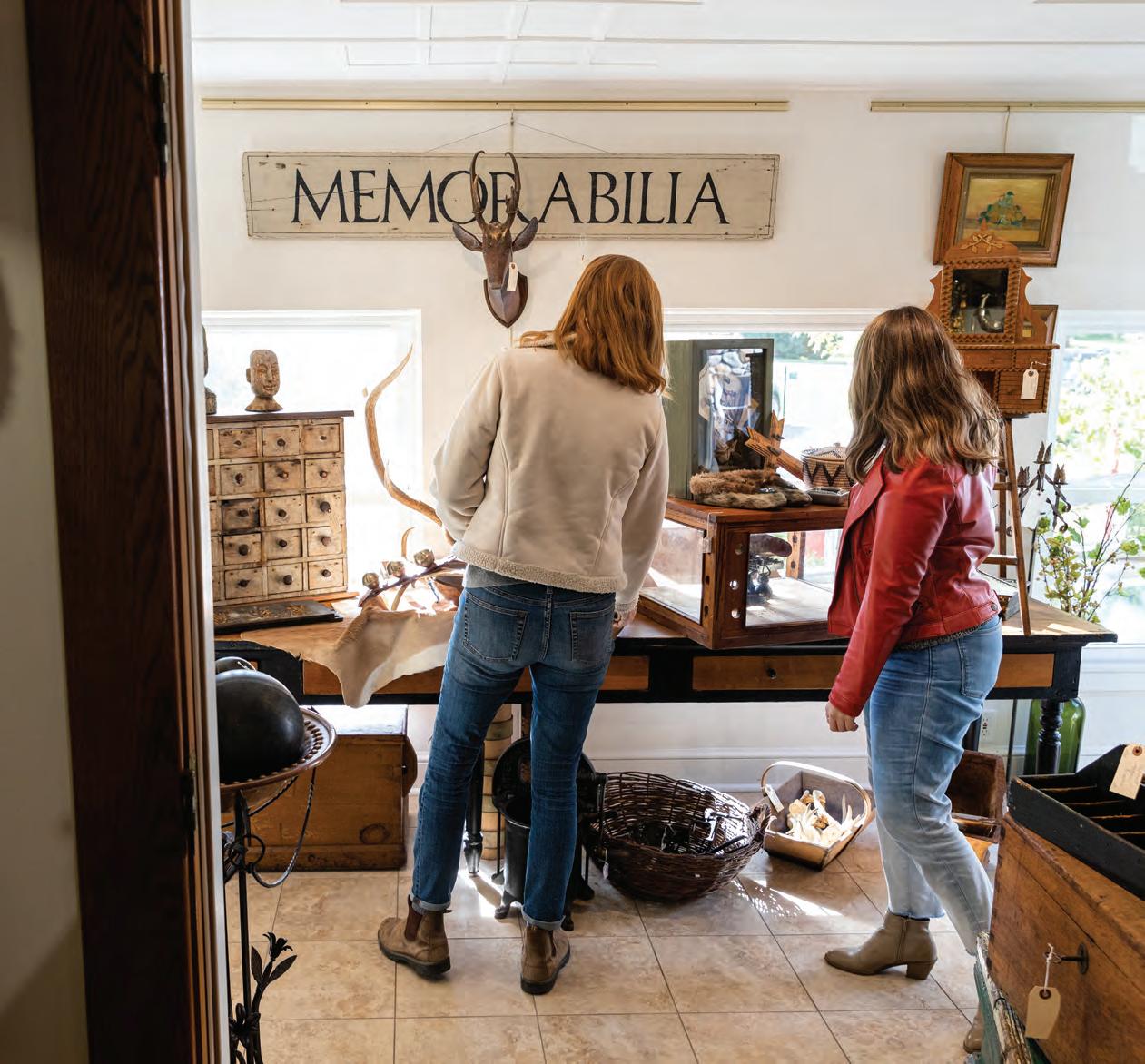
Elk Rapids
Set right on US-31 just south of downtown Elk Rapids (and its restaurants, shops and sandy beaches) is a white home surrounded by maple trees. A hydrangea bush anchors the front porch that’s heavy with lush hanging ferns. Inside the 3,000-square-foot antique boutique, each room holds a surprise—a refurbished Elgin National Coffee Mill grinder from the late 1800s, chicken-shaped ice cream molds, hutches that’ll make you weak in the knees. Go upstairs for more.
Fun finds: Larger home pieces—furniture, lighting, art, architectural elements—abound.

Don’t miss: Margot the Shop, a tiny stone cottage out back with thoughtfully curated delights. Walk through the bright red front door to find timeworn vintage pieces, home goods from world travels and stellar widebrimmed hats.
Stop for: A quick jaunt down Elk Lake Road will land you at The Granary at Seven Gables. The Michigan Centennial Farm has a gift shop bursting with goodies (we left with a jar of locally made red raspberry jam). A robin’s-egg-blue–trimmed outbuilding called Grandma’s Garage is brimming with antiques and collectibles—wooden snowshoes, cowboy boots, cast iron cookware (scored a skillet for making apple crisp). An honor-system roadside farm stand has cinnamon-roasted almonds, juicy Honeycrisp apples, fuzzy peaches and the season’s last tomatoes.
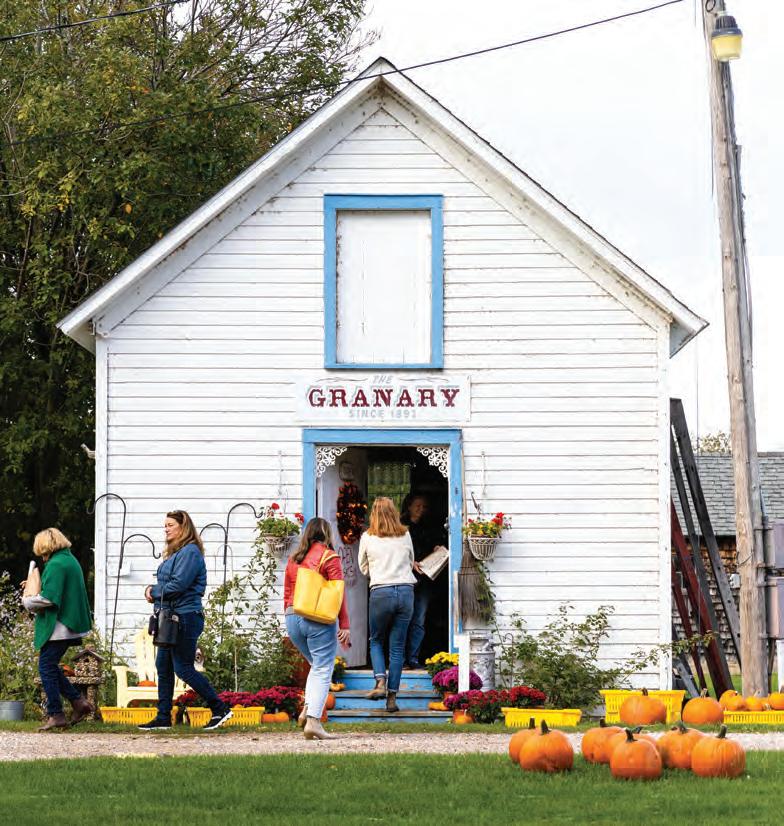
We fell in love with: Carly was smitten with a ceramic pretzel-shaped flask, complete with chunky flakes of salt, which was tucked away in a locked glass case. Cara doted on a rocking horse whose ears, mane and tail had been completely loved off.
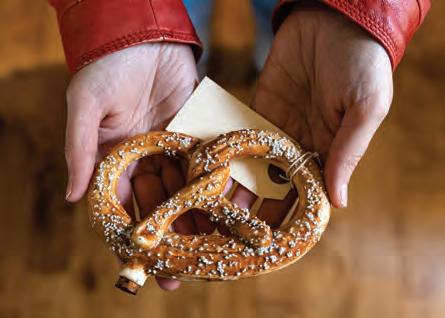
Walt and Susan’s Old Barn Antiques Old Mission Peninsula
This husband-and-wife pair has run the out of-the-way antique biz for more than 50 years—a passion project that began when they acquired a circa 1910 barn and its contents, which they attempted to clean out and sell. But instead of making way for space in the barn, it sparked a love of antiques and collectibles that resulted in growing their stash into a business, with Susan becoming an appraiser and Walt creating a separate offshoot to house his automotive antiques in “Walt’s Garage” just up the hill.
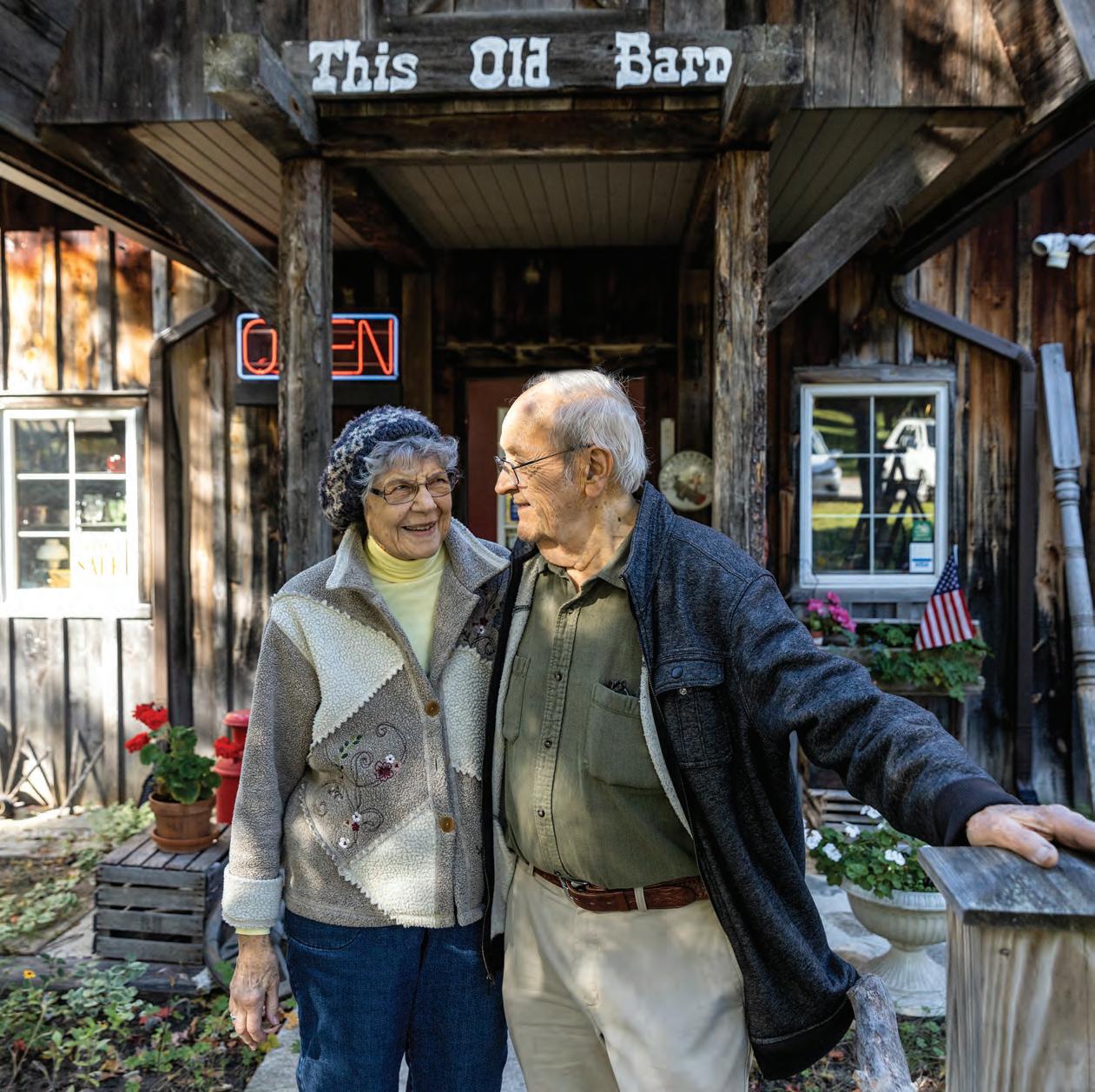
Fun finds: Look for Victorian and Gatsby-era hats, dresses and shoes in the barn attic, as well as vintage tools, kitchenware, textiles and terrific local postcards.
Don’t miss: Walt’s Garage. Just up the hill from the old barn is Walt’s collection, a near museumlevel homage to all things automotive. Car buffs will swoon over the antique gas pumps and globes, as well as the huge stash of vintage leather Michigan license plates.
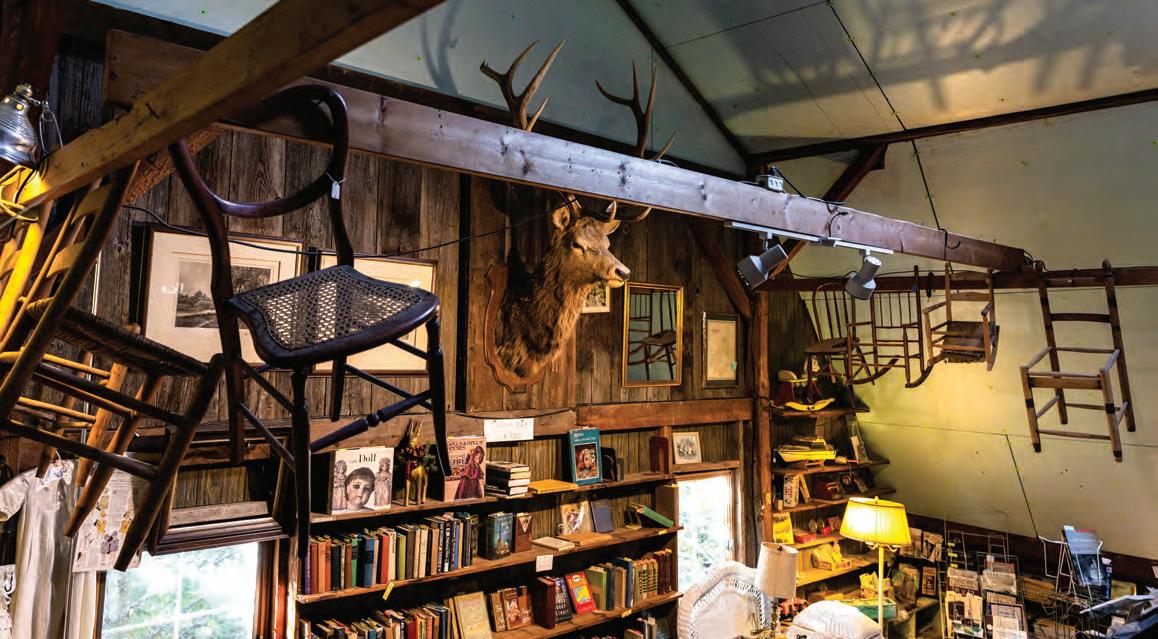
Stop for: September on Old Mission Peninsula means the air is awash in the scent of ripening grapes and fresh apples, and a host of wineries and cideries beg to be explored. With an eye for the vintage vibe, head to Peninsula Cellar’s one-room-schoolhouse tasting room and kick back with a hard-cider sampler before committing to a pint of your fave—the maple bourbon is subtle, dry and delicious on a bluebird day.

We fell in love with: Fur mittens. Rabbit? Bear? Coyote? Fox? Who knows? Lissa knows they will keep her mitts (wrists and elbows!) toasty warm on a winter walk.
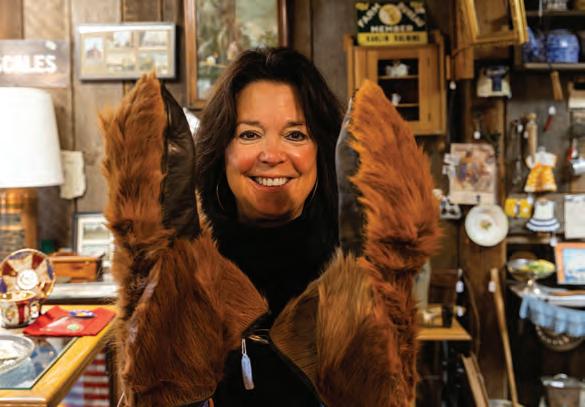
DESTINATION Rolling Hills Antiques Traverse City
Ii
An 1870 dairy barn turned antique shop is hidden away on Barney Road. You’ll find it down a tree-lined driveway (it is indeed on a rolling hill). Owners Glen and Diane Lundin specialize in American antique furniture, art, oriental rugs and accessories from the early 1700s to mid-1900s. When we visited, there was an 1835 solid cherry desk that had been owned by Oprah Winfrey until she sold it at an auction in 2013 to raise money for her Leadership Academy for Girls in South Africa. Talk about a conversation starter.
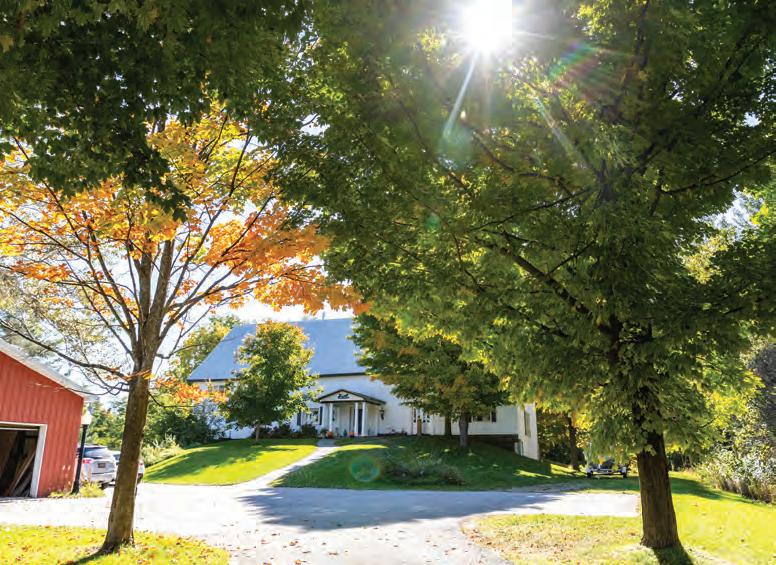
Fun finds: If you’re on the hunt for gorgeous oriental rugs, this is the spot.
Don’t miss: The barn’s loft, complete with a creaky wooden floor and soaring ceiling, is full of little treasures—tea sets, jewelry boxes, lamps.

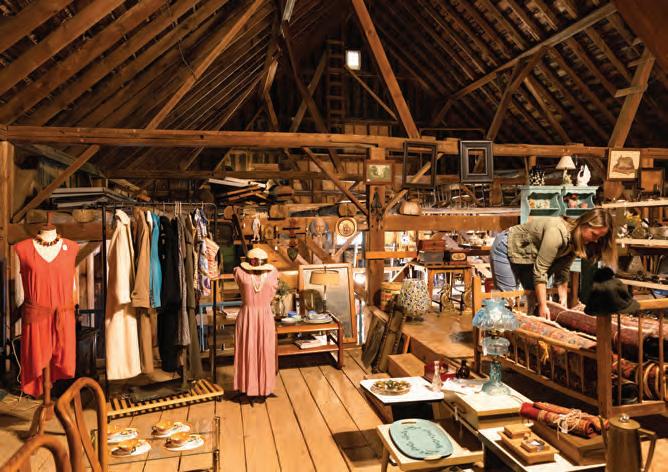
Stop for: Farm Club. Yes, it is a working farm, but it’s also a destination market, restaurant and brewery with a large, family-friendly lawn and plenty of outdoor seating. The menu changes throughout the year—gemelli pasta with celery root crème and garlicky breadcrumbs, saskatoon shortcake, a blackened zucchini sandwich with basil mayo and mozzarella. (The onion rings, made with a sweet onion variety called Ailsa Craig, are legendary, and you must order them if you visit while they’re in season.)
The market at Farm Club is stocked daily with fresh bread, produce and canned beer along with gorgeous cookbooks, pottery and those gourmet salts that are so fun to sprinkle. Prepare to be tempted.
We fell in love with:
A magnificent hanging stained glass with a vibrant floral design.
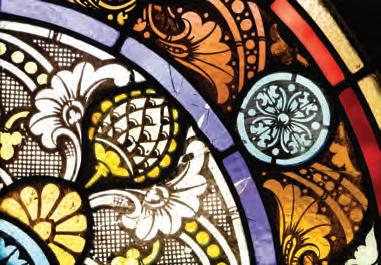
Destination
Black Horse Antiques Beulah
When Jill Rineer was deciding what to name her antique shop, just three blocks north of charming downtown Beulah, she landed on a combination of her maiden name and her favorite animal (which makes her collection of Black Horse pub signs and figurines throughout the shop even more whimsically wonderful). Jill’s vibrant vintage patio furniture will catch your eye outside, but step inside for a well-curated collection of glassware, kitchen décor and gorgeous pieces like a mid-century modern Heywood-Wakefield drop-leaf table, or a primitive pine cupboard.
Fun finds: Jill’s assortment of glassware is impressive—a rainbow of cups from the ’60s and ’70s covered in prints of fruits and flowers. While browsing, we came across a teacup with an odd semicircular ledge inside, and a half-moon shaped opening. The label— “mustache cup”—piqued Allison’s interest, and a quick Google search later, she found that it was invented in the 1870s by a British potter, designed for men to, of course, keep their whiskers dry while sipping. Having no such need herself, she left the mustache guard behind.
Don’t miss: The refurbished patio chairs and deck furniture, which come in almost any design and color you can imagine. A seafoam green chair. A pastel blue bench. A neon yellow rocker. You’ll feel like a kid in a candy shop.

Stop for: The giant Bavarian pretzel and craft beer cheese at Five Shores Brewing. Pair it with a Local Legend lager or a Te Quiero amber.
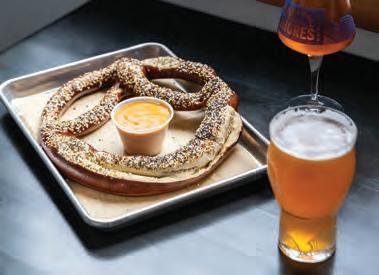
We fell in love with: Allison was drawn to a periwinkle blue ceramic Lipton teapot. Collectors say these vintage pots were made by the Hall China Company in East Liverpool, Ohio, for Lipton Tea.

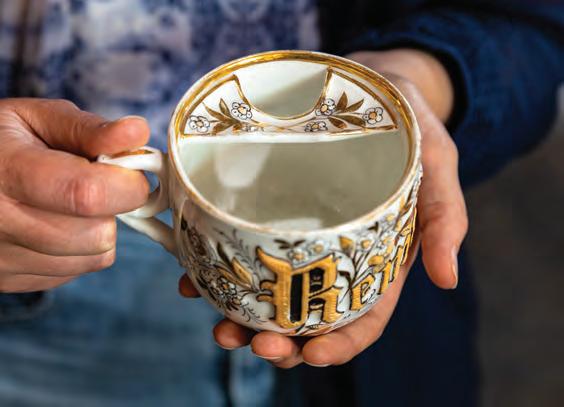
A renowned painter looks back on a career that was ignited in the amber glow of the Northern Michigan countryside.
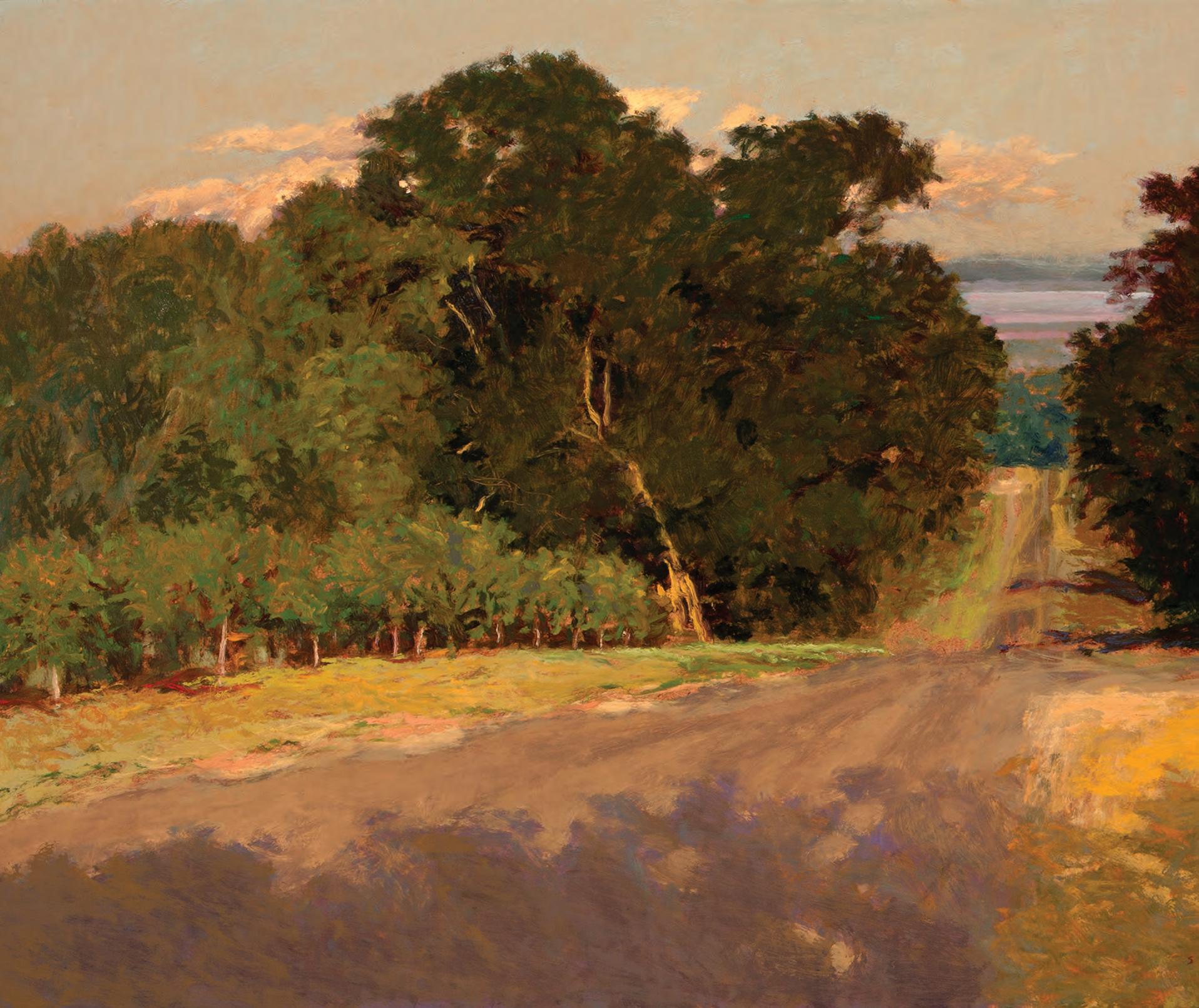
by Patty LaNoue Stearns










